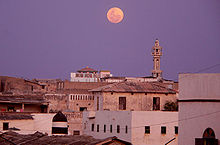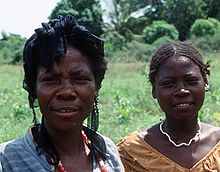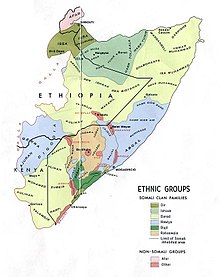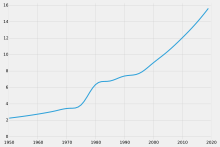Somalia
![]()
This article is about the East African state. For the celestial body named after it, see (1430) Somalia; for the Brazilian footballer, see Wergiton do Rosário Calmon.
Template:Infobox State/Maintenance/NAME-German
Somalia (Somali Soomaaliya; Italian Somalia, Arabic الصومال, DMG aṣ-Ṣūmāl) or Federal Republic of Somalia (full form of the state name since 2012) refers to a federal state in the far east of Africa on the Horn of Africa. The name is derived from the Somali people, who form the majority of the population and also reside in neighbouring countries. The state was formed by the merger of the colonial territories of British and Italian Somaliland, which became independent together in 1960 ("African Year"). The national territory borders the Indian Ocean to the east, the Gulf of Aden to the north, Djibouti and Ethiopia to the west and Kenya to the south.
Somalia is considered an extremely fragile and undeveloped state, both in terms of political and economic development. After the fall of the authoritarian government under Siad Barre in 1991, no functioning central government existed for more than 20 years due to the still ongoing civil war. The transitional governments formed from 2000 onwards under the protection of the international community were largely unsuccessful; at times they were barely able to keep the capital under their control. Large parts of the country fell into the hands of local clans, warlords, radical Islamist groups or pirates. Regional de facto regimes formed on the national territory. Of these regimes, however, only Somaliland in the northwest chose to form an independent new nation. The others claimed autonomy as self-governing constituent states, but did not abandon the idea of a common Somali state.
Since the new constitution came into force on 1 August 2012, a majority of the regional regimes have been participating as federal states in the reconstruction of a joint administration. Successes against the radical Islamist militias in 2012 made it possible to elect a joint Somali government again for the first time in August 2012. The status of Somaliland, which is considered a constituent state by Somalia although it continues to seek international recognition as a neighboring state independent of Somalia and which is embroiled in a still unresolved border dispute with Puntland, remains unclear. Some regions in central and southern Somalia continued to be dominated by al-Shabaab in 2019.
Geography
→ Main article: Geography of Somalia
Somalia is located in the east of the African continent, on the Horn of Africa in the Somali Peninsula. The northern part of the country is mostly mountainous, with an average elevation of 900 to 2100 m above sea level in the Somali Highlands; the highest mountain is Shimbiris (2460 m). Towards the south stretches a lowland with an average altitude of 180 m. The rivers Jubba and Shabeelle originate in Ethiopia and flow through southern Somalia and thus through the Somali Desert into the Indian Ocean.
Somalia is influenced by monsoon winds, a hot climate all year round, irregular rainfall and constantly recurring dry periods. Except in the mountainous and coastal regions, the average maximum daytime temperature is between 30 and 40 °C. The southwestern monsoon provides a relatively mild climate in the Mogadishu area during the months of May to October. Between December and February, the northeastern monsoon brings a similar mild climate. In the so-called Tangambili period between the two monsoons (October to November and March to May), it is hot and humid.
Environment
Erosion and desertification are the main environmental problems of Somalia. Causes are overgrazing and deforestation of the remaining forests, as wood is the country's main source of energy and since the outbreak of the civil war charcoal has been exported to the states of the Arabian Peninsula on a larger scale.
The mangrove areas between Kismaayo and the Kenyan border in the south of the country and the coral reefs on the Gulf of Aden and near Kenya are also affected by land degradation and degradation.
In the absence of an effective coast guard, illegal nuclear and toxic waste disposal (dumping) takes place off the country's coast, and foreign fishing fleets overfish the waters uncontrollably.
(167).jpg)
Hills in Northern Somalia/Somaliland
Population
The inhabitants of Somalia are called Somalis (the Somali, the Somali). Occasionally, the term Somali is also used imprecisely, but this only includes the ethnic Somali, i.e. it does not include the non-Somali minorities in the country.
The last census whose results were published was in 1975, and the UNFPA published a study in 2014 that used surveys and satellite imagery to determine a total population of over 12.3 million. In 2019, Somalia had a population of 15.4 million, according to UN calculations. The fertility rate was a very high 6 children per woman by global standards, although in the late 1990s there were still about 7.5 children born per woman. For the year 2050, according to the UN's medium population forecast, the population is expected to exceed 35 million, which will put strong pressure on the country's limited resources.
Today, about 25 percent of all Somalis live partly or entirely as nomads. 22 percent of the people live as farmers who have settled in the most fertile region of the country between the Shabeelle and Jubba rivers. Most of the population (42 percent) lives in urban areas. There are still over one million people (9 percent of the total population) displaced in Somalia, most of whom live in 107 refugee camps.
Ethnicities
Somalia was long considered one of the most ethnically homogeneous countries and one of the few "nation states" in Africa, as the vast majority of the population belongs to the Somali people. This image has changed since the differences between the various Somali clans and between Somali and ethnic minorities, especially in southern Somalia, became more apparent during the civil war.
Somali clans
By far the most important ethnic group in terms of proportion are the Somali, whose settlement area also extends to eastern Ethiopia (Somali region), Djibouti and north-eastern Kenya and who, according to current knowledge, are of Cushitic-African and partly Arab-Persian descent.
Of great importance to Somali society and politics is the Somali clan system, which was probably influenced by the tribal society of the Arabs. Every Somali belongs to a tribe or clan through his paternal lineage. The five major clan families (qabiil) are:
- Darod
- You
- Hawiye
- Isaaq
- Rahanweyn (or Digil-Mirifle).
The traditionally nomadic Dir, Darod, Isaaq and Hawiye are considered "real Somali" or Samaal, while the sedentary peasant Rahanweyn are referred to as "fake Somali" or Sab. They, as well as various ethnic minorities, are not considered equal from the point of view of a part of the Samaal and are traditionally subject to social discrimination.
Each of these clan families breaks down into a large number of subclans and "genders" (Somali: reer, meaning "people from", "descendants of"). These each comprise a few hundred to a thousand men, who jointly pay or receive the blood money (diya, mag) due for crimes. This system traditionally provides the individual Somali with protection for life and property, but also leads to blood feuds that not only relate to individual crimes, but also include disputes over water and grazing rights and political power.
Minorities
Non-Somali minorities make up about 15% of the population. These include various black African ethnic groups in southern Somalia, collectively referred to by the Somali as Jarer ("hard-haired" or "curly-haired"). Some of these are descended from slaves brought to Somalia in the 19th century by the East African slave trade from Tanzania, Malawi, Mozambique, and Kenya, most of whom settled in the Jubba Valley after escaping or being freed. They have been known as Somali Bantu since the 1990s. For other Jarer groups, such as the Shidle, the origin is still considered unclear; they may be descended from a pre-Somali population.
Other minorities include members of Swahili society and groups of mixed origin on the coast (e.g. Bajuni, Brawanese, Benadiri/Reer Hamar), groups spread throughout the country such as the Yibir and Midgan, who are confined to certain occupations, as well as a few thousand Arabs and a few hundred Indians and Pakistanis.
Languages
The main language of Somalia is Somali (proper name Af-ka Soomaali-ga) - an Eastern Cushitic language from the language branch of the Cushitic languages and thus part of the Afro-Asiatic language family - which is spoken today by about 12 million people in Somalia and adjoining areas. The language of the Somali people is also used by all minorities in Somalia.
Arabic and - as a legacy of the colonial era - Italian and English are also used as languages of trade and education. A small part of the Somali Bantu has retained the Bantu language Zigula. On the coast, small minorities (the Bajuni in and around Kismaayo and the Brawanese in Baraawe) speak dialects of Swahili.
As the only African state besides Tanzania, Somalia developed away from the use of European colonial languages after its independence. Somali nationalists strove for the standardization and codification of Somali. This came to fruition in 1972 under Siad Barre and was made the official language. Somali then rapidly gained acceptance in administration, education and the media, while Italian, English and Arabic declined in importance accordingly. The basis for the standard Somali was the variant Maha Tiri (Maxaa Tiri), spoken mainly in the north; the other main variant is Maay, which is widespread in the south, and there are other dialects.
The Somali Transitional Constitution of 2004 establishes Somali (Maay and Maha Tiri) and Arabic as official languages. Italian and English have a status as secondary languages.
Religion
Almost 100 % of the population of Somalia belongs to the Sunni branch of Islam. Of these, about 80 % are Shafiites and 20 % Hanafites. The only non-Muslims in Somalia are a few hundred Christians, almost all of foreign origin. The few Christian Somalis belong to the Ethiopian Orthodox Tewahedo Church. Individual missionary attempts and the building of a cathedral of Mogadishu with an attached Catholic monastery in the colonial period had no major effect. Both were destroyed during the civil war. With it also the Roman Catholic diocese of Mogadishu de facto dissolved. The last bishop had already been shot in the cathedral in 1989.
The traditional practice of Islam in Somalia is rather moderate in the villages and among nomads and mixed with the customary law of the clans. There, the schools of faith spread by missionary sheikhs of various Sufi orders in the 19th century are present in everyday life. The oldest and largest of these brotherhoods is the Qadiriyya, followed by the Salihiyya in the north. Smaller groups include the Dandarawiyya, the most widespread branch of the Idrisiyya founded in the late 19th century by Muhammad ibn Ahmad al-Dandarawi, and the Rifaiyya, an offshoot of the Qadiriyya popular among Arab immigrants in Mogadishu. Since the 1970s, there have been radical Wahhabi currents, especially in the cities, which gained in importance during the civil war, as did the religion as a whole.
Since the outbreak of the civil war, Islamic institutions have been among the few institutions offering education, medical care or even justice. The growing influence of Islam has different effects on the situation of women: Islamic law brings them certain improvements in inheritance law compared to customary law, and some clerics today also speak out against the widespread circumcision of girls; on the other hand, women are increasingly pressured to veil themselves more or to withdraw from public spaces altogether. Al-Shabaab enforces a strict interpretation of Shari'a law in southern and central Somalia. It also has links to al-Qaeda and has jihadists from abroad in its ranks.
The constitution of the transitional government designates Islam as the official religion of the Republic of Somalia and stipulates that legislation is to be based on Shari'a law. The constitution of Somaliland, which was unilaterally declared independent, also declares Islam to be the religion of the nation and prohibits the "propagation" - which already includes the public practice - of other religions in Somaliland. Apostasy from Islam is punished with draconian penalties, including flogging.

Moon and minaret in Merka

Poem by Mohammed Abdullah Hassan in Somali written in the Latin alphabet.

Bantu women farmers near Kismaayo, 1993

Somali Clan Map

Somali children

Age pyramid in 1000 inhabitants

Population development in millions of inhabitants
Questions and Answers
Q: What is Somalia?
A: Somalia is a country located on the Horn of Africa.
Q: What is the official name of Somalia?
A: The official name of Somalia is the Federal Republic of Somalia.
Q: What does Somalia border?
A: Somalia borders Djibouti to the northwest, Kenya with Yemen to the north, the Guardafui Channel and Somali Sea to the east, and Ethiopia to the west.
Q: What was Somalia previously known as?
A: Somalia used to be known as the Somali Republic.
Q: What do you call a person from Somalia?
A: A person from Somalia is called a Somali.
Q: What is the language spoken in Somalia?
A: The official languages of Somalia are Somali and Arabic.
Q: What is the capital of Somalia?
A: The capital of Somalia is Mogadishu.
Search within the encyclopedia